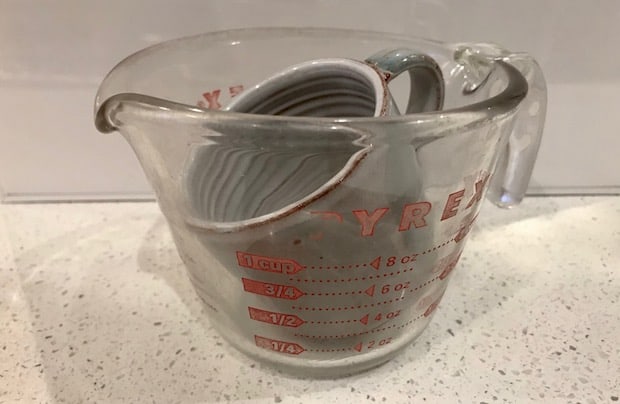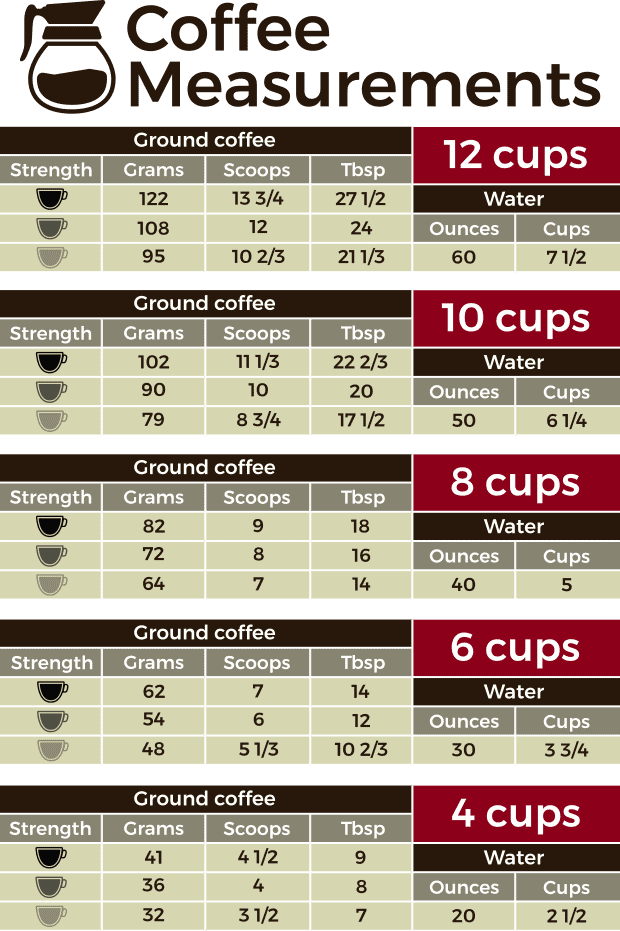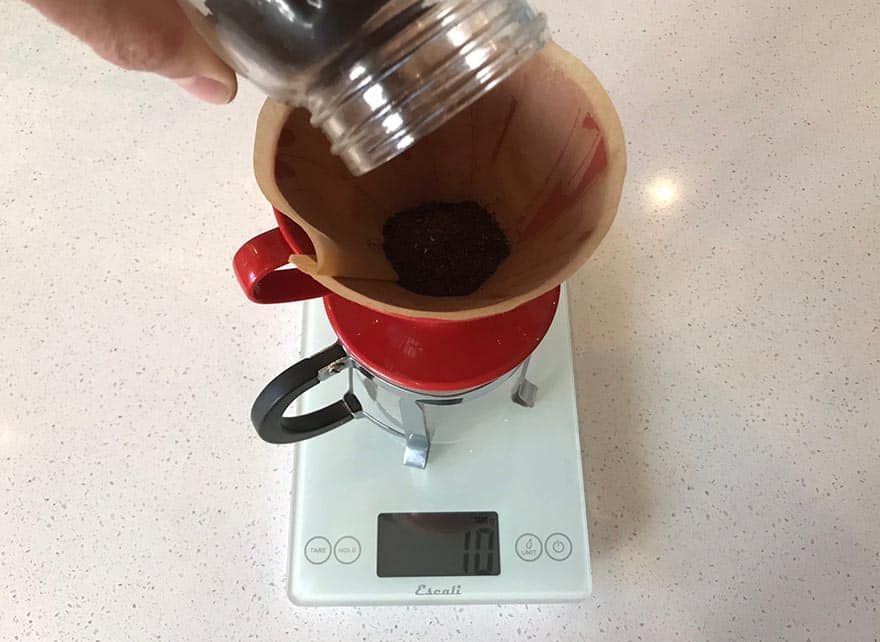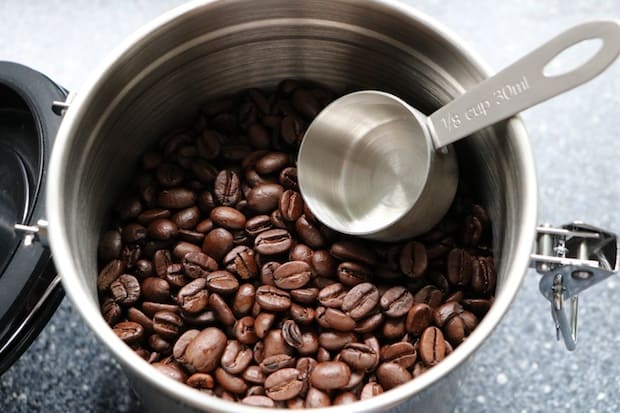Last Updated on December 3, 2023
Determining how much coffee grounds per cup to use when brewing can be challenging, because cup sizes vary.
A cup of coffee requires nine grams (2 tbsp) of coffee and five ounces (⅝ cup) of water if you define a “cup” by the lines on your coffee maker’s water reservoir. Use two tablespoons of ground coffee per cup for a classic 1:16 coffee-to-water ratio. This produces perfect coffee of average strength.
But keep in mind that the cups you actually drink from at your breakfast table may be twice that volume (or more). If you’re talking about those cups, you should use four tablespoons per cup.
To make things even more confusing, a standard kitchen measuring cup is somewhere between those two.
So the first step is to be clear on your definition of a cup, and the volume of liquid it holds. This will make it so much easier to figure out how much coffee to use.
Key Takeaways
- For average strength coffee, use 2 tbsp (1 coffee scoop) of ground coffee for every ⅝ cup of water.
- Your coffee maker’s definition of a “cup” is probably a lot smaller than the cups you actually drink.
- Since cup size can vary, it’s better to think of coffee measurements in terms of coffee-to-water ratio.
- A coffee-to-water ratio of 1:16 will produce coffee of average strength.
In this post we provide the recommended coffee measurements for just about any volume of coffee you’d like to make. These are all based on coffee that is already ground. For whole beans, you can use the same amount if measuring by weight, but use only 3/4 as much if measuring by volume.
We provide our ground coffee measurements in grams, coffee scoops and tablespoons. For large percolator batches, we also provide them in standard measuring cups (8 fl. oz. or 250 mL).
We provide our water measurements in ounces and measuring cups, and also quarts for large percolator batches.
IMPORTANT: Most coffee-maker manufacturers consider a standard coffee cup to be four ounces, so that’s what we’ve used here. Of course, this is much smaller than the cups most of us actually drink. However, your drip coffee brewer is likely calibrated for this size. If it’s an 8-cup machine, it uses 40 ounces of water to brew 32 ounces of coffee after 20 per cent of the hot water is absorbed during the brewing process.

We’ve done the math for you in the handy chart below. Download it, print it and stick it to your fridge with a magnet so you’re always ready to make perfect coffee.

Printable Coffee Ratio Chart
Send download link to:
For a Standard, 4-Ounce Cup
The amount of ground coffee you need per cup of coffee depends on the size of your cups and how strong you want your coffee. For a four-ounce coffee cup brewed to average strength using five ounces of water (some of which is absorbed by the coffee grounds or evaporated during brewing), you should use nine grams of coffee.
Scoops Per Cup
Use one standard level coffee scoop, or two level tablespoons, for the standard four-ounce coffee cup described above.
For Strong Coffee
For strong coffee, use 10 grams of ground coffee. For milder coffee, use eight grams. If you use a scoop or a tablespoon, just add or take away about 10 per cent from level.
For a Large Mug
If your coffee cups are larger than four ounces, you can multiply the standard amounts by two or three.
For example, a household measuring cup is eight ounces. If that’s the size of your coffee cup, then double the amount of coffee and brew it with 10 ounces of water. If you have a large mug (the size of a Starbucks ‘tall’ cup), then triple the amount of coffee and brew with 15 ounces of water.
Ground Coffee Required for Different Volumes of Coffee
12 Cups

To brew a 12-cup pot of coffee at average strength, use 108 grams of coffee and 60 ounces (7 1/2 measuring cups) of water. That’s about 12 level scoops of coffee, or 24 level tablespoons.
To make the coffee strong, use 122 grams of coffee (13 3/4 scoops or 27 1/2 tablespoons). To make it mild, use 95 grams (10 2/3 scoops or 21 1/3 tablespoons).
10 Cups

To make 10 cups of coffee at average strength, use 90 grams of coffee and 50 ounces (6 1/4 measuring cups) of water. That’s about 10 level scoops of coffee, or 20 level tablespoons.
To make the coffee strong, use 102 grams of coffee (11 1/3 scoops or 22 2/3 tablespoons). To make it mild, use 79 grams (8 3/4 scoops or 17 1/2 tablespoons).
8 Cups

To make eight cups of coffee at average strength, use 72 grams of coffee and 40 ounces (5 measuring cups) of water. That’s about 8 level scoops of coffee or 16 level tablespoons.
To make the coffee strong, use 82 grams of coffee (nine scoops or 18 tablespoons). To make it mild, use 64 grams (7 scoops or 14 tablespoons).
6 Cups

To make six cups of coffee at average strength, use 54 grams of coffee and 30 ounces (3 3/4 measuring cups) of water. That’s about 6 level scoops of coffee, or 12 level tablespoons.
To make the coffee strong, use 62 grams of coffee (7 scoops or 14 tablespoons). To make it mild, use 48 grams (5 1/3 scoops or 10 2/3 tablespoons).
5 Cups

To make five cups of coffee at average strength, use 45 grams of coffee and 25 ounces (3 measuring cups) of water. That’s about 5 level scoops of coffee, or 10 level tablespoons.
To make the coffee strong, use 51 grams of coffee (5 2/3 scoops or 11 1/3 tablespoons). To make it mild, use 40 grams (4 1/2 scoops or 9 tablespoons).
4 Cups

To make four cups of coffee at average strength, use 36 grams of coffee and 20 ounces (2 1/2 measuring cups) of water. That’s about 4 level scoops of coffee, or 8 level tablespoons.
To make the coffee strong, use 41 grams of coffee (4 1/2 scoops or 9 tablespoons). To make it mild, use 32 grams (3 1/2 scoops or 7 tablespoons).
2 Cups

To make two cups of coffee at average strength, use 18 grams of coffee and 10 ounces (1 1/4 measuring cups) of water. That’s about 2 level scoops of coffee, or 4 level tablespoons.
To make the coffee strong, use 21 grams (2 1/3 scoops or 4 2/3 tablespoons). To make it mild, use 16 grams (1 3/4 scoops or 3 1/2 tablespoons).
30 Cups

At this volume, you’re probably brewing in a large coffee percolator. For average strength, use 270 grams of coffee, or 3/5 of a pound (9.5 ounces). That’s 3 3/4 measuring cups if you’re going by volume.
Use 150 ounces of water, which is 17 3/4 cups or 4 1/2 quarts.
40 Cups

For average strength, use 360 grams of coffee or 4/5 of a pound (12.7 ounces). That’s 5 measuring cups if you’re going by volume.
Use 200 ounces of water, which is 23 2/3 cups or 6 quarts.
Coffee-to-Water Ratio
All these measurements are calculated by knowing the golden ratio of how much coffee to water you need for various strengths of coffee. These are the coffee-to-water ratios we find work best:
| Strength of coffee | Parts coffee | Parts water |
|---|---|---|
| Strong | 1 | 14 |
| Average | 1 | 16 |
| Mild | 1 | 18 |
Feel free to play around with these ratios, though. You won’t go wrong by using 1:17 or 1:15, we can assure you of that!
These ratios apply to all hot brewing methods, from filter coffee to French press to espresso. If you’re making cold brew, which is coffee concentrate brewed at a lower water temperature, you’ll want to increase the ratio of coffee to water. Many cold brew aficionados use ratios between 1:5 and 1:10.
Do You Measure Coffee By Weight or Volume?
If you’re wondering how to measure coffee-to-water ratio, it is typically done by weight. For coffee of average strength, your water should be 16 times the weight of your coffee. Our coffee measurements here include not only weight but also volumes—such as scoops, tablespoons and ounces. These have been calculated based on the typical weight of coffee using those volume measures.
How to Measure Coffee
The best way to measure coffee is with a scale. In this section we discuss how to properly measure coffee using a scale, as well as various other common methods. This should help you decide what to use to measure coffee in your own kitchen.
With a Scale
A coffee scale is really no different than a regular kitchen scale. Sometimes coffee scales come with built-in timers to help with timing the pour for those who manually brew pour-over coffee. But otherwise, a regular digital kitchen scale will do just fine.
Turn on your scale, and you should be able to select the unit to display. We recommend grams, as provided in the coffee measurements above. Consult your user manual if you can’t find the controls for switching between units.

The important thing to remember about kitchen scales is that they have a “tare” function—usually indicated by a button—that resets them to zero, even after you have placed something on the scale. This is really helpful because it means you can measure your coffee into a cup or bowl and the scale won’t count the weight of the cup or bowl.
Here’s how you do it:
- Tare your scale to zero.
- Place the cup/bowl on the scale. Its weight will display.
- Hit “tare” again to reset to zero.
- Add your ground coffee. Now it is weighing only the coffee.
Once you’ve reached the desired number of grams, you have all the coffee you need for brewing.
You can weigh your water the same way if you want, but it might be simpler to just use the volume measures we’ve provided above. We have accounted for the weight of the water.
Without a Scale
To measure coffee without a scale, you basically have two options:
- a scoop
- a spoon
But not just any scoop or spoon. Ideally, you’ll have a standard coffee scoop, or a proper tablespoon measure.
With a Scoop
To measure coffee with a standard coffee scoop, just dip your scoop into the coffee grounds or pour your grounds into the scoop. You want the coffee grounds to be level with the top of the scoop, rather than heaping, so use a finger or the flat edge of a knife to slide any extra aside.
How Much is a Coffee Scoop?
A typical coffee scoop is equivalent to two tablespoons, or 30 milliliters. If your coffee maker comes with a scoop, or if one was included with the ground coffee you bought from the store, it is almost certainly a 2-tbsp coffee scoop.
With a Spoon
You can measure coffee with a tablespoon the same way you would with a scoop: by dipping the spoon into the coffee grounds and then leveling the top with your finger or the flat edge of a knife.
If you don’t have a proper measuring tablespoon, use any regular large spoon to estimate the amount by picturing how much coffee would fit in a tablespoon. Your coffee might end up a little strong or a little weak, but you won’t be too far off unless you are making a huge pot.
Do You Measure Coffee Before or After Grinding?
Some people prefer to measure coffee beans vs. ground coffee. This is OK if you are using a scale and measuring by weight, because the coffee should weigh approximately the same before and after you grind.
However, if you use a volume measure you will end up with very different results before and after grinding. Grinding puts a lot of space and air between the individual particles of coffee, so a scoopful of ground coffee will weigh only about 3/4 as much as a scoopful of coffee beans, which are more dense. The volume measurements we provided above are all based on ground coffee.



